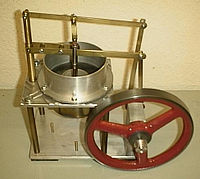
Photo from wikipedia
Abstract Despite the higher efficiency, oxygen-enriched combustion (OEC) suffers from high NOx emission. To promote its application, this paper proposes a new conceptual burner which could maintain the high efficiency… Click to show full abstract
Abstract Despite the higher efficiency, oxygen-enriched combustion (OEC) suffers from high NOx emission. To promote its application, this paper proposes a new conceptual burner which could maintain the high efficiency while effectively reduce NOx emission. The burner is basically developed based on the concept of moderate or intense low-oxygen dilution (MILD) combustion, but the further novelty lies in the isolation of fuel and oxygen by an inert gas stream, which is supposed to postpone the reaction between fuel and oxygen and accelerate the establishment of MILD combustion regime. CFD (Computational Fluid Dynamics) simulation work has been conducted under three oxygen concentrations (19.5%, 23%, and 26.5%) to investigate the combustion behaviors of the novel burner following a detailed validation of the experimental case employing the original MILD combustion burner. Comparisons are made between the present proposed burner and the original burner in terms of temperature and species distributions, as well as NOx emission, for the three oxygen concentrations. The numerical results show that applying the novel burner can reduce the peak temperature obtained with the original burner by 106 K, 62 K and 58 K in three oxygen concentrations respectively. Meanwhile, the standard deviations of the temperature decreases by 24–54% in the special line, and all approximately 10% in the symmetric plane in the three oxygen concentrations. These observations suggest the enhanced uniformity of temperature distribution by using the novel burner, which is mainly due to the extended reaction zone together with the postponed reaction. As a result of the well-established MILD combustion status, the NOx emission can be reduced to 1/8, 1/5 and 1/2 of the original magnitude when using the novel burner at the oxygen concentration 19.5%, 23%, and 26.5% respectively.
Journal Title: Applied Thermal Engineering
Year Published: 2019
Link to full text (if available)
Share on Social Media: Sign Up to like & get
recommendations!